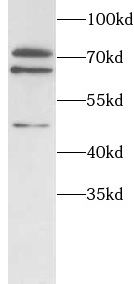Products
ITK antibody
Category:
| Synonyms: | EMT antibody, IL2 inducible T cell kinase antibody, ITK antibody, Kinase EMT antibody, LYK antibody, PSCTK2 antibody, T cell specific kinase antibody, Tyrosine protein kinase Lyk antibody | ||
| Catalogue No.: | FNab10711 | Reactivity: | Human |
| Host: | Rabbit | Tested Application: | ELISA, IHC, WB |
| Clonality: | polyclonal | Isotype: | IgG |
- SPECIFICATIONS
- Product Name
- ITK antibody
- Catalogue No.
- FNab10711
- Size
- 100μg
- Form
- liquid
- Purification
- Immunogen affinity purified
- Purity
- ≥95% as determined by SDS-PAGE
- Clonality
- polyclonal
- Isotype
- IgG
- Storage
- PBS with 0.02% sodium azide and 50% glycerol pH 7.3, -20℃ for 12 months(Avoid repeated freeze / thaw cycles.)
Immunogen
- Immunogen
- IL2-inducible T-cell kinase
- Alternative Names
- EMT antibody, IL2 inducible T cell kinase antibody, ITK antibody, Kinase EMT antibody, LYK antibody, PSCTK2 antibody, T cell specific kinase antibody, Tyrosine protein kinase Lyk antibody
- UniProt ID
- Q08881
- Observed MW
- 68-72kd
Application
- Tested Applications
- ELISA, IHC, WB
- Recommended dilution
- WB: 1:200-1:2000; IHC: 1:20-1:200
Validated Images
 Jurkat cells were subjected to SDS PAGE followed by western blot with FNab10711(ITK antibody) at dilution of 1:1000
Jurkat cells were subjected to SDS PAGE followed by western blot with FNab10711(ITK antibody) at dilution of 1:1000
 Immunohistochemistry of paraffin-embedded human kidney tissue slide using FNab10711(ITK antibody) at dilution of 1:100
Immunohistochemistry of paraffin-embedded human kidney tissue slide using FNab10711(ITK antibody) at dilution of 1:100
- Background
- Tyrosine kinase that plays an essential role in regulation of the adaptive immune response. Regulates the development, function and differentiation of conventional T-cells and nonconventional NKT-cells. When antigen presenting cells(APC) activate T-cell receptor(TCR), a series of phosphorylation lead to the recruitment of ITK to the cell membrane, in the vicinity of the stimulated TCR receptor, where it is phosphorylated by LCK. Phosphorylation leads to ITK autophosphorylation and full activation. Once activated, phosphorylates PLCG1, leading to the activation of this lipase and subsequent cleavage of its substrates. In turn, the endoplasmic reticulum releases calcium in the cytoplasm and the nuclear activator of activated T-cells(NFAT) translocates into the nucleus to perform its transcriptional duty. Phosphorylates 2 essential adapter proteins: the linker for activation of T-cells/LAT protein and LCP2. Then, a large number of signaling molecules such as VAV1 are recruited and ultimately lead to lymphokine production, T-cell proliferation and differentiation.



